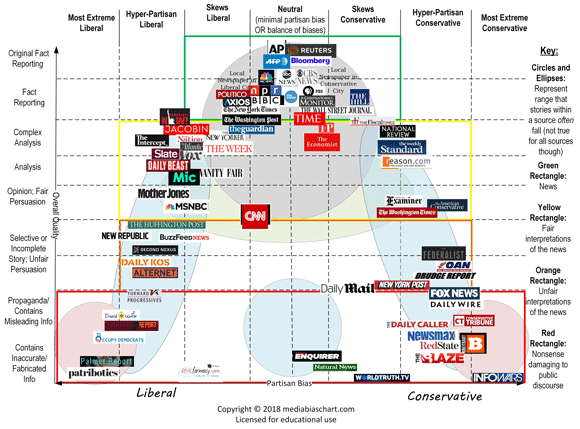In this week’s column, chief strategy officer Brad Berens explores why having too many news sources makes it hard to tell what’s true.
_______________________________________________________________________________________
On March 10, a MarketWatch story, “How biased is your news source? You probably won’t agree with this chart,” featured the remarkable Media Bias chart created by patent attorney Vanessa Otero.
(Click on the chart for a larger version, or go here.)
This is the third version of Otero’s chart. Regardless of whether you agree or disagree with how she rates media sources and constructs the chart, her methodology is thoughtful and consistent. And, to the extent that objectivity is possible in these matters, Otero seems so. She isn’t making her living as a journalist or working for a news property, and doesn’t accept advertising on her site. In other words, she does not have a dog in this fight on either side of the partisan divide. (See her FAQ page for a detailed discussion of this.)
While Otero’s chart is fascinating when it comes to information quality, what intrigues me most is the underlying quantitative issue.
Here’s what I mean.
Otero’s chart graphically reveals the political biases of more than 70 different media entities– 70 is a large number. There are few surprises: on the right Alex Jones’ “Infowars” is the most biased and least truthful (See this bracing 2017 piece on Jones for details) while “Patribiotics” is a counterpart on the left. The Associated Press and Reuters sit at the tip of the pyramid as the least biased and most truthful media platforms.
Looking underneath Otero’s chart, though, we can begin to see the extent to which the vast number of media sources changes our experience of any single media source.* Context can be confusing.
The alarming thing about Alex Jones and Infowars, for example, is not any of the absurd, false claims that he makes. Instead, what’s worrisome about Infowars is that it normalizes Fox News.
In Otero’s analysis, about 2/3 of Fox content falls into the “red rectangle,” which means that it’s “nonsense damaging to public discourse” and the other 1/3 in the orange rectangle is merely “unfair interpretations of the news.” Despite the network’s slogan, in Otero’s view none of Fox is “fair and balanced,” but it appears to be so when compared to Infowars.
_________________________________________________________________________________________________
Today, with the evaporation of distribution costs and the data-driven pairing of ads and programs, viewers cannot depend on the old proxies, and so they are left to decide for themselves with no obvious or reliable way to make that decision. Hence, “fake news.”
_________________________________________________________________________________________________
There are too many sources positioning themselves as news with no easy criteria to help viewers judge whether or not the source is credible, so viewers make relatively arbitrary decisions about what to watch and what to trust.
This isn’t just true of news. According to Nielsen, in 2016 Americans on average received 206 TV channels but watched just 20 of them. With too many channels hemorrhaging too much programming at them all day, every day, Americans create consideration sets of what they will watch in order to combat decision fatigue.
Consideration sets aren’t a societal problem when it comes to game shows, soap operas or sit-coms, but they are when it comes to news.
Forty years ago things were different. Viewers weren’t overwhelmed by too many media properties clamoring for their attention. In 1978, there were three national news broadcasts, PBS, weekly national news magazines, and local newspapers. All were appealing to as broad an audience as possible, and so while there was bias (towards a straight white Christian male point of view), ABC, NBC and CBS had more in common than not. Even if it was incomplete, there was a shared national discourse.
Moreover, the cost of running a network acted as a partial proxy for credibility, and the support of advertisers acted as a further proxy because viewers could plausibly conclude that if a program was hyper-partisan then Procter and Gamble, Coca-Cola, and Ford probably wouldn’t implicitly endorse them with ads.
CNN arrived in 1980, and its new 24-hour news cycle required the creation of vastly more programming in order to fill the time — another quantitative issue that changed quality. Then, in 1996, Fox News premiered and chose to compete through partisan opposition to the Clinton administration.
Today, with the evaporation of distribution costs and the data-driven pairing of ads and programs, viewers cannot depend on the old proxies, and so they are left to decide for themselves with no obvious or reliable way to make that decision.
Hence, “fake news.”
For those of a liberal persuasion, it would be easy to blame President Trump for the extent to which “fake news” has become an easy label to stick onto any media story that an individual doesn’t like. And while the president does indeed frequently deploy “fake news,” it is a mistake to conclude that this is entirely a Trumpian phenomenon.
In the Center’s 2017 “Surveying the Digital Future” report, for example, we can see that our respondents’ faith in news on the web was already declining even before the 2016 presidential race:

Fewer people thought all content was reliable; more people thought a small portion or about half was reliable, and in 2015 the percentage of respondents who thought that most online news was accurate and reliable had declined from a peak of 66 to 61 percent. In 2016, that “most” number fell even further, to 55 percent.
Both Otero’s chart and the increasing use of “fake news” as a label show that we as a society don’t have a functional definition of what “news” really is in the first place. Of course, professional journalists do have standards, but it’s challenging to determine who counts as a professional journalist and who is just a guy with a blog.
For a few dollars a month in hosting costs, anybody can create a website, download a free “Newspaper” WordPress theme, and have a media property that looks just like an actual newspaper’s site. It’s hard to tell the difference, and therefore hard to agree.
If we can’t agree on what news is, then it’s easy to say that something is “fake news” because there’s no test to determine when something is or isn’t news. It all becomes a matter of opinion, which is why “fake news” is truly scary.
__________
* Neither Otero in her chart nor I in this column are considering Facebook, Twitter, or Google as media sources despite the fact that many people get to media through these platforms. Nor are either of us exploring late-night TV shows or partisan talk radio, which are also frequently viewers’ first exposure to the stories of the day. These are topics for future columns.

Brad Berens is the Center’s Chief Strategy Officer.
See all columns from the Center.
April 17, 2018


